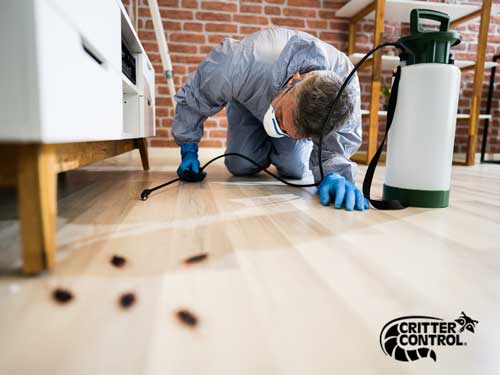A1 Pest Control Charlotte NC Bed Bugs - Specialist Elimination Services
Wiki Article
Bed Bug Therapy Breakdown: Comparing Chemical Vs. Non-Chemical Solutions
In the world of bug control, particularly when dealing with the persistent problem of bed bugs, the selection between chemical and non-chemical therapy options can be a critical one. Both strategies use distinct benefits and drawbacks, affecting factors such as performance, safety factors to consider, and general price. By taking a look at the nuanced information of each technique, a more clear understanding of which path to seek in dealing with a bed pest infestation can be acquired.Efficiency of Chemical Therapies
Chemical treatments for bed pest invasions have actually been commonly recognized for their potent and rapid efficiency in removing these pests. When thinking about the effectiveness of chemical treatments, it is critical to comprehend that they can give a extensive and quick option to a bed bug issue. Specialist pest control operators typically depend on insecticides to target bed insects at numerous stages of their life process, consisting of adults, eggs, and fairies. These chemicals usually work by interrupting the bed bugs' nerve system, causing paralysis and ultimate fatality.Additionally, chemical therapies have the benefit of supplying recurring results, suggesting that they can remain to eliminate bed bugs also after the preliminary application. This residual action is particularly beneficial in combating any kind of possible re-infestations. Furthermore, the rapid action of chemical therapies can bring relief to individuals facing extreme bed insect infestations, allowing them to reclaim control of their home promptly.
Safety Problems With Chemical Solutions
One critical facet that calls for mindful factor to consider when utilizing chemical options for bed insect treatment is guaranteeing the security of passengers and the setting. Direct exposure to specific chemicals utilized in bed bug treatments can lead to breathing problems, skin irritation, or other damaging responses, specifically in people with pre-existing problems or sensitivities.Moreover, the ecological effect of chemical remedies is an additional considerable consideration. Some chemicals utilized in bed insect treatments may be harmful to valuable bugs, wildlife, and environments if they leach into the dirt or water systems. It is necessary to use chemical treatments deliberately, complying with safety standards, and taking into consideration much less hazardous alternatives to minimize these dangers and ensure the efficient and secure administration of bed pest problems.
Benefits of Non-Chemical Approaches
Taking into consideration the possible security concerns and environmental influence associated with chemical remedies for bed bug treatment, discovering non-chemical approaches provides an appealing choice with numerous distinct benefits. Non-chemical treatments are ecologically friendly, as they do not add to air or water air pollution, making them a lasting selection for bug control.In addition, non-chemical options can be efficient in targeting bed insects, including hard-to-reach areas where chemical treatments might not pass through. Approaches such as warmth treatment, vacuuming, steam cleaning, and cushion encasements give thorough eradication without using hazardous chemicals. Furthermore, non-chemical approaches can be less disruptive, calling for marginal preparation and permitting quicker reentry right into dealt with areas. On the whole, going with non-chemical bed insect treatment approaches not only focuses on security and environmental defense however also makes certain effective and detailed parasite control.
Limitations of Non-Chemical Treatments

In addition, non-chemical treatments frequently call for several applications to achieve effective removal. This can be time-consuming and may not constantly ensure complete removal of all bed bugs and their eggs, specifically in concealed or hard-to-reach locations.
Furthermore, the success of non-chemical therapies heavily relies upon proper execution and thoroughness, which can be challenging for people without professional proficiency. Poor application of non-chemical methods might result in insufficient eradication, causing persistent invasions and the need for extra therapies.
For that reason, while non-chemical therapies have their advantages, it is vital to acknowledge these restrictions and consider them when establishing the most efficient strategy for managing bed insect infestations.
Expense Contrast: Chemical Vs. Non-Chemical Options
Provided the restrictions associated with non-chemical therapies, an essential facet to review in the context of bed insect management is the cost comparison in between chemical and non-chemical choices. In contrast, non-chemical therapies like warm treatment or vapor can be a lot more expensive, with prices varying from $1,000 to $6,000 for an entire home. While the first expense of chemical treatments might appear lower, numerous treatments might be needed to fully get rid of the invasion, potentially raising the general cost.Final Thought

Thinking about the prospective security concerns and ecological impact linked with chemical options for bed bug therapy, checking out non-chemical approaches offers an appealing choice with a number of distinctive advantages.Given the restrictions associated with non-chemical therapies, a vital facet to examine in the context of bed bug administration A1 exterminator charlotte nc is the cost contrast between chemical and non-chemical choices. In comparison, non-chemical treatments like warmth treatment or vapor can be more pricey, with costs ranging from $1,000 to $6,000 for a whole home. While the initial price of chemical treatments might seem lower, numerous treatments may be called for to fully remove the infestation, possibly enhancing the total cost.In final thought, when contrasting chemical and non-chemical bed bug therapy alternatives, it is necessary to consider efficiency, security, advantages, limitations, and price.
Report this wiki page